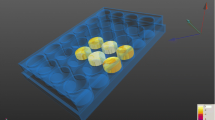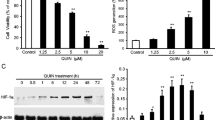Abstract
In the present study, we investigated whether Raf-1 kinase inhibitory protein (RKIP) is important for neural cell apoptosis induced by microwave exposure and explored the role of MEK/ERK/CREB pathway regulated by RKIP in the apoptosis. Differentiated PC12 cells were exposed to continuous microwave radiation at 2.856 GHz for 5 min with average power density of 30 mW/cm2. RKIP sense and anti-sense recombinant plasmids were constructed and transfected into PC12 cells, respectively. Terminal deoxynucleotidyl transferase (TdT)-mediated dUTP nick end labeling (TUNEL) staining and caspase-3 activity assay were used to detect cell apoptosis. The results showed that RKIP was downregulated after microwave exposure while the MEK/ERK/CREB signaling pathway was activated excessively. Moreover, the ratio of Bcl-2/Bax decreased, activity of caspase-3 increased, and thus apoptotic DNA fragmentation increased. RKIP overexpression significantly inhibited the phosphorylation of MEK, ERK, and CREB, while RKIP downregulation had the reverse effect. Furthermore, U0126 was found to antagonize the changes caused by RKIP downregulation after exposure to radiation. In conclusion, RKIP plays an important role in the neural cell apoptosis induced by microwave radiation, and the regulation of cell apoptosis by RKIP is partly through the MEK/ERK/CREB pathway. This suggests that RKIP may act as a key regulator of neuronal damage caused by microwave radiation.





Similar content being viewed by others
References
Salford LG, Brun AE, Eberhardt JL, Malmgren L, Persson BRR (2003) Nerve cell damage in mammalian brain after exposure to microwaves from GSM mobile phones. Environ Health Perspect 111(7)
Dubreuil D, Jay T, Edeline J-M (2002) Does head-only exposure to GSM-900 electromagnetic fields affect the performance of rats in spatial learning tasks? Behav Brain Res 129(1-2):203–210. doi:10.1016/s0166-4328(01)00344-8
Dirk Matthias H, Konstantin-Alexander H (1997) Neurological effects of microwave exposure related to mobile communication. J Neurol Sci 152(1):1–14
Campisi A, Gulino M, Acquaviva R, Bellia P, Raciti G, Grasso R, Musumeci F, Vanella A, Triglia A (2010) Reactive oxygen species levels and DNA fragmentation on astrocytes in primary culture after acute exposure to low intensity microwave electromagnetic field. Neurosci Lett 473(1):52–55. doi:10.1016/j.neulet.2010.02.018
Bernier I, Jollés P (1984) Purification and characterization of a basic 23 kDa cytosolic protein from bovine brain. Biochim Biophys Acta Protein Struct Mol Enzymol 790(2):174–181. doi:10.1016/0167-4838(84)90221-8
Banfield MJ, Barker JJ, Perry ACF, Brady RL (1998) Function from structure? The crystal structure of human phosphatidylethanolamine-binding protein suggests a role in membrane signal transduction. Structure (Lond, Engl: 1993) 6(10):1245–1254
Keller ET, Fu Z, Brennan M (2004) The role of Raf kinase inhibitor protein (RKIP) in health and disease. Biochem Pharmacol 68(6):1049–1053. doi:10.1016/j.bcp.2004.04.024
Goel R, Baldassare JJ (2004) Killing two birds with one RKIP. Trends Endocrinol Metab 15(3):91–92. doi:10.1016/j.tem.2004.02.004
al-Mulla F, Bitar MS, Taqi Z, Rath O, Kolch W (2011) RAF kinase inhibitory protein (RKIP) modulates cell cycle kinetics and motility. Mol BioSyst 7(3):928–941
Yeung K, Seitz T, Li S, Janosch P, McFerran B, Kaiser C, Fee F, Katsanakis KD, Rose DW, Mischak H, Sedivy JM, Kolch W (1999) Suppression of Raf-1 kinase activity and MAP kinase signalling by RKIP. Nature 401(6749):173–177
Lorenz K, Lohse MJ, Quitterer U (2003) Protein kinase C switches the Raf kinase inhibitor from Raf-1 to GRK-2. Nature 426(6966):574–579
Berkeley JL, Levey AI (2003) Cell-specific extracellular signal-regulated kinase activation by multiple G protein-coupled receptor families in hippocampus. Mol Pharmacol 63(1):128–135. doi:10.1124/mol.63.1.128
Tang H, Park S, Sun S-C, Trumbly R, Ren G, Tsung E, Yeung KC (2010) RKIP inhibits NF-κB in cancer cells by regulating upstream signaling components of the IκB kinase complex. FEBS Lett 584(4):662–668. doi:10.1016/j.febslet.2009.12.051
Ojika K, Mitake S, Tohdoh N, Appel SH, Otsuka Y, Katada E, Matsukawa N (2000) Hippocampal cholinergic neurostimulating peptides (HCNP). Prog Neurobiol 60(1):37–83. doi:10.1016/s0301-0082(99)00021-0
Ma J, Li F, Liu L, Cui D, Wu X, Jiang X, Jiang H (2009) Raf kinase inhibitor protein inhibits cell proliferation but promotes cell migration in rat hepatic stellate cells. Liver Int 29(4):567–574. doi:10.1111/j.1478-3231.2009.01981.x
Hellmann J, Rommelspacher H, Mühlbauer E, Wernicke C (2010) Raf kinase inhibitor protein enhances neuronal differentiation in human SH-SY5Y cells. Dev Neurosci 32(1):33–46
Rosner M (2007) MAP kinase meets mitosis: a role for Raf kinase inhibitory protein in spindle checkpoint regulation. Cell Div 2(1):1
Trakul N, Rosner MR (2005) Modulation of the MAP kinase signaling cascade by Raf kinase inhibitory protein. Cell Res 15(1):19–23
Keller ET (2004) Metastasis suppressor genes: a role for raf kinase inhibitor protein (RKIP). Anti Cancer Drugs 15(7):663–669
Maki M, Matsukawa N, Yuasa H, Otsuka Y, Yamamoto T, Akatsu H, Okamoto T, Ueda R, Ojika K (2002) Decreased expression of hippocampal cholinergic neurostimulating peptide precursor protein mRNA in the hippocampus in Alzheimer disease. J Neuropathol Exp Neurol 61(2):176–185
George A, Gordon L, Beissbarth T, Koukoulas I, Holsinger R, Perreau V, Cappai R, Tan S-S, Masters C, Scott H, Li Q-X (2010) A serial analysis of gene expression profile of the Alzheimer’s disease Tg2576 mouse model. Neurotox Res 17(4):360–379. doi:10.1007/s12640-009-9112-3
George AJ, Holsinger RMD, McLean CA, Tan S-S, Scott HS, Cardamone T, Cappai R, Masters CL, Li Q-X (2006) Decreased phosphatidylethanolamine binding protein expression correlates with Aβ accumulation in the Tg2576 mouse model of Alzheimer's disease. Neurobiol Aging 27(4):614–623. doi:10.1016/j.neurobiolaging.2005.03.014
Berenger J (1994) A perfectly matched layer for the absorption of electromagnetic waves. J Comput Phys 114:185–200
Schuderer J, Kuster N (2003) Effect of the meniscus at the solid/liquid interface on the SAR distribution in petri dishes and flasks. Bioelectromagnetics 24(2):103–108
Varela J, Page J, Esteban J (2010) Design, implementation, and dosimetry analysis of an S-band waveguide in vitro system for the exposure of cell culture samples to pulsed field. Bioelectromagnetics 31(6):479–487
Marampon F, Casimiro MC, Fu M, Powell MJ, Popov VM, Lindsay J, Zani BM, Ciccarelli C, Watanabe G, Lee RJ, Pestell RG (2008) Nerve growth factor regulation of cyclin D1 in PC12 cells through a p21RAS extracellular signal-regulated kinase pathway requires cooperative interactions between Sp1 and Nuclear Factor-κB. Mol Biol Cell 19(6):2566–2578
Chatterjee D, Bai Y, Wang Z, Beach S, Mott S, Roy R, Braastad C, Sun Y, Mukhopadhyay A, Aggarwal BB, Darnowski J, Pantazis P, Wyche J, Fu Z, Kitagwa Y, Keller ET, Sedivy JM, Yeung KC (2004) RKIP sensitizes prostate and breast cancer cells to drug-induced apoptosis. J Biol Chem 279(17):17515–17523. doi:10.1074/jbc.M313816200
Odabaei G, Chatterjee D, Jazirehi AR, Goodglick L, Yeung K, Bonavida B (2004) Raf-1 kinase inhibitor protein: structure, function, regulation of cell signaling, and pivotal role in apoptosis. Adv Cancer Res 91:169–200
Lents NH, Keenan SM, Bellone CJ, Baldassare JJ (2002) Stimulation of the Raf/MEK/ERK cascade is necessary and sufficient for activation and Thr-160 phosphorylation of a nuclear-targetec CDK2. J Biol Chem. doi:10.1074/jbc.M207425200, M207425200
Dasdag S, Akdag MZ, Ulukaya E, Uzunlar AK, Ocak AR (2009) Effect of mobile phone exposure on apoptotic glial cells and status of oxidative stress in rat brain. Electromagn Biol Med 28(4):342–354
Murphy LO, Smith S, Chen R-H, Fingar DC, Blenis J (2002) Molecular interpretation of ERK signal duration by immediate early gene products. Nat Cell Biol 4(8):556–564
Arendt T, Holzer M, Großmann A, Zedlick D, Bruückner MK (1995) Increased expression and subcellular translocation of the mitogen activated protein kinase kinase and mitogen-activated protein kinase in Alzheimer's disease. Neuroscience 68(1):5–18. doi:10.1016/0306-4522(95)00146-a
Colucci-D'Amato L, Perrone-Capano C, di Porzio U (2003) Chronic activation of ERK and neurodegenerative diseases. Bioessays 25(11):1085–1095. doi:10.1002/bies.10355
Dineley KT, Westerman M, Bui D, Bell K, Ashe KH, Sweatt JD (2001) β-Amyloid activates the mitogen-activated protein kinase cascade via hippocampal α7 nicotinic acetylcholine receptors: in vitro and in vivo mechanisms related to Alzheimer’s disease. J Neurosci 21(12):4125–4133
Pei J-J, Braak H, An W-L, Winblad B, Cowburn RF, Iqbal K, Grundke-Iqbal I (2002) Up-regulation of mitogen-activated protein kinases ERK1/2 and MEK1/2 is associated with the progression of neurofibrillary degeneration in Alzheimer’s disease. Mol Brain Res 109(1–2):45–55. doi:10.1016/s0169-328x(02)00488-6
Klysik J, Theroux SJ, Sedivy JM, Moffit JS, Boekelheide K (2008) Signaling crossroads: the function of Raf kinase inhibitory protein in cancer, the central nervous system and reproduction. Cell Signal 20(1):1–9. doi:10.1016/j.cellsig.2007.07.003
Bartus R, Dean R, Beer B, Lippa A (1982) The cholinergic hypothesis of geriatric memory dysfunction. Science 217(4558):408–414. doi:10.1126/science.7046051
Sagisaka T, Matsukawa N, Toyoda T, Uematsu N, Kanamori T, Wake H, Borlongan CV, Ojika K (2010) Directed neural lineage differentiation of adult hippocampal progenitor cells via modulation of hippocampal cholinergic neurostimulating peptide precursor expression. Brain Res 1327:107–117. doi:10.1016/j.brainres.2010.02.071
Ruan L, Wang G-L, Yi H, Chen Y, Tang C-E, Zhang P-F, Li M-Y, Li C, Peng F, Li J-L, Chen Z-C, Xiao Z-Q (2010) Raf kinase inhibitor protein correlates with sensitivity of nasopharyngeal carcinoma to radiotherapy. J Cell Biochem 110(4):975–981. doi:10.1002/jcb.22611
Christ A, Kuster N (2005) Differences in RF energy absorption in the heads of adults and children. Bioelectromagnetics 26(S7):S31–S44. doi:10.1002/bem.20136
Mantiply ED, Pohl KR, Poppell SW, Murphy JA (1997) Summary of measured radiofrequency electric and magnetic fields (10 kHz to 30 GHz) in the general and work environment. Bioelectromagnetics 18(8):563–577. doi:10.1002/(sici)1521-186x(1997)18:8<563::aid-bem5>3.0.co;2-0
ICNIRP (2009) ICNIRP statement on the "Guidelines for limiting exposure to time-varying electric, magnetic, and electromagnetic fields (up to 300 GHz)". Health Phys 97(3):257–258
Acknowledgments
This work was supported by the National Natural Science Foundation of China (30770527, 81102101), the Military Medical Fund (CWS11J073), and the Major National Science and Technology Program of China (2008ZXJ09004-019). We sincerely thank professor Fu Hanjiang for providing the plasmid vector and Dr. Zhang Zhiyi, Zhou Peilan, Xu Chengwang, and Zhou Hongmei for their excellent technical assistance.
Conflict of Interest
All authors declared that there are no conflict of interest.
Author information
Authors and Affiliations
Corresponding authors
Additional information
Hongyan Zuo and Tao Lin contributed equally to this work.
Rights and permissions
About this article
Cite this article
Zuo, H., Lin, T., Wang, D. et al. RKIP Regulates Neural Cell Apoptosis Induced by Exposure to Microwave Radiation Partly Through the MEK/ERK/CREB Pathway. Mol Neurobiol 51, 1520–1529 (2015). https://doi.org/10.1007/s12035-014-8831-5
Received:
Accepted:
Published:
Issue Date:
DOI: https://doi.org/10.1007/s12035-014-8831-5




